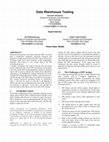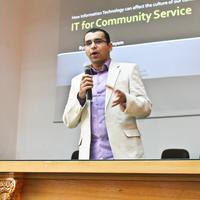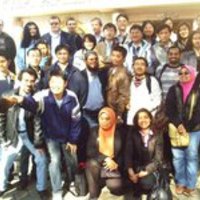Papers by Galal H Galal-Edeen
Data warehouse (DW) testing is a very critical
stage in the DW development because decisions are... more Data warehouse (DW) testing is a very critical
stage in the DW development because decisions are made based
on the information resulting from the DW. So, testing the quality
of the resulting information will support the trustworthiness of
the DW system. A number of approaches were made to describe
how the testing process should take place in the DW
environment. In this paper we will present briefly these testing
approaches, and then a proposed matrix that structures the DW
testing routines will be used to evaluate and compare these
approaches. Afterwards an analysis of the comparison matrix
will highlight the weakness points that exist in the available DW
testing approaches. Finally, we will point out the requirements
towards achieving a homogeneous DW testing framework. In the
end, we will conclude our work.

Joint EDBT/ICDT PhD Workshop, 2013, Genoa, Italy, Mar 22, 2013
During the development of the data warehouse (DW), too much
data is transformed, integrated, st... more During the development of the data warehouse (DW), too much
data is transformed, integrated, structured, cleansed, and
grouped in a single structure that is the DW. These various types
of changes could lead to data corruption or data manipulation.
Therefore, DW testing is a very critical stage in the DW
development process.
A number of attempts were made to describe how the testing
process should take place in the DW environment. In this paper,
I will state briefly these testing approaches, and then a proposed
matrix will be used to evaluate and compare these approaches.
Afterwards, I will highlight the weakness points that exist in the
available DW testing approaches. Finally, I will describe how I
will fill the gap in the DW testing in my PhD by developing a
DW Testing Framework presenting briefly its architecture.
Then, I will state the scope of work that I am planning to
address and what type of limitations that exist in this area that I
am expecting to experience. In the end, I will conclude my
work and state possible future work in the field of DW testing.

This paper discusses our experience in building a framework for effort estimation and applying it... more This paper discusses our experience in building a framework for effort estimation and applying it in a local environment of sample Egyptian companies. The framework focuses on minimizing effort variance by enhancing the adjustments made to the functional sizing techniques. A special focus was made on the adjustment factors, which reflects the application's complexity and the actual environment in which this application will be implemented. We introduced the idea of grouping the adjustment factors to simplify the process of adjustment and to ensure more consistency in the adjustments. We have also studied how the quality of requirements impact effort estimation. We introduced the quality of requirements as an adjustment factor in our proposed framework. We have applied the proposed framework on a sample of a group of Egyptian companies with an objective to enhance effort estimation in these companies.

One of the most important reasons behind the failure of the previous generations of Business to B... more One of the most important reasons behind the failure of the previous generations of Business to Business (B2B) e-Commerce hubs was their solutions architectures. These B2B solutions architectures did not match the requirements of a business environment that needs flexible and innovative approaches to interact with market changes, business procedures, competition and day-to-day business practices. The paper uses the EDI Reference model, which is provided by the ISO organization to analyze the challenges of the architectures of B2B e-Commerce hubs. These challenges are summarized in: (A) a document-centric focus rather than business-process focus; (B) the complexity of creating new business models, or business services at runtime; (C) the interoperability limitations, and the data transformation challenges. The research presents a proposed architecture to build solutions architectures for B2B e-Commerce hubs. The proposed solution creates a clear, automatic path between the business specification layer and the technical implementation layer by combining both a Service Oriented Architecture (SOA) and management views in a single framework. The paper assesses the capabilities of the proposed architecture in building vertical B2B e-Marketplaces by applying the proposed architecture to the building of a vertical B2B e-Marketplace for the Oil and Gas sector. Further decomposition of the Business Process Execution Language (BPEL) with semantic match making (reasoning techniques) has not been covered completely in the scope of this research, and future research can be extended to enhance this architecture.
Reverse Engineering, 2002. Proceedings. …, Jan 1, 2002
This paper adopts a fresh look at the activities of software architecting and re-architecting. It... more This paper adopts a fresh look at the activities of software architecting and re-architecting. It is suggested that looking at software architecture at a level that transcends the components and connectors concerns, and into the categoric differentiation of types of constructional ...
… Process Management Journal, Jan 1, 2009
Logistics Information Management, Jan 1, 2003
The Egyptian Informatics Journal, Jan 1, 2005
Systems engineering methods that adopt a socio-technical perspective (such as the Soft Systems Me... more Systems engineering methods that adopt a socio-technical perspective (such as the Soft Systems Method) have attracted, and continue to attract, a great amount of interest from researchers and practitioners in the fields of information systems and even in hard systems engineering. ...
Journal of Enterprise …, Jan 1, 2010
Purpose The previous generations of implemented B2B e-commerce hub solutions (e-Marketplaces) d... more Purpose The previous generations of implemented B2B e-commerce hub solutions (e-Marketplaces) did not successfully fulfil the requirements of buyers and suppliers (Participants) in different business domains to carry out their daily business and online ...
Computer Engineering & Systems, …
Talks by Galal H Galal-Edeen

This is a position paper that aims to introduce a novel perspective that we hope will motivate a ... more This is a position paper that aims to introduce a novel perspective that we hope will motivate a discussion in a direction useful for reverse-architecting efforts. This paper is fundamentally a philosophical think-piece that tries to draw the attention of the software engineering community to a deeper, and we argue is more useful, view of software architecture.
This paper adopts a fresh look at the activities of software architecting and re-architecting. It is suggested that looking at software architecture at a level that transcends the components and connectors concerns, and into the categoric differentiation of types of constructional elements is more beneficial for the evolvability and adaptability concerns of software. This view, which is termed “software architectonics’ is proposed as a focus for software re-architecting activities. The views presented herein are grounded in various readings of the Architecture proper and urban morphology disciplines.

This is a position paper that introduces a novel perspective that we hope will motivate a discuss... more This is a position paper that introduces a novel perspective that we hope will motivate a discussion in a direction useful for system architecting efforts. The paper is fundamentally a philosophical think piece that tries to draw the attention of the information systems engineering community to a deeper, and we argue is more useful, view of the concept of systems architecture.
This paper adopts a fresh look at the activities of systems architecting. It is suggested that the architectural view of systems and other technical artefacts should transcend the structural level, which is mainly concerned with constructional elements or components and how these are fitted to one another, into the categoric differentiation of types of constructional elements. The latter is a more coarse-grained, and contextually-bound view that specifically aimed at the evolvability and adaptability concerns of systems. This view, which is termed “systems architectonics’ is proposed as a focus for systems architecting thinking and activities. The views presented herein are grounded in various readings of the Architecture proper, urban morphology, philosophy and sociology.











Uploads
Papers by Galal H Galal-Edeen
stage in the DW development because decisions are made based
on the information resulting from the DW. So, testing the quality
of the resulting information will support the trustworthiness of
the DW system. A number of approaches were made to describe
how the testing process should take place in the DW
environment. In this paper we will present briefly these testing
approaches, and then a proposed matrix that structures the DW
testing routines will be used to evaluate and compare these
approaches. Afterwards an analysis of the comparison matrix
will highlight the weakness points that exist in the available DW
testing approaches. Finally, we will point out the requirements
towards achieving a homogeneous DW testing framework. In the
end, we will conclude our work.
data is transformed, integrated, structured, cleansed, and
grouped in a single structure that is the DW. These various types
of changes could lead to data corruption or data manipulation.
Therefore, DW testing is a very critical stage in the DW
development process.
A number of attempts were made to describe how the testing
process should take place in the DW environment. In this paper,
I will state briefly these testing approaches, and then a proposed
matrix will be used to evaluate and compare these approaches.
Afterwards, I will highlight the weakness points that exist in the
available DW testing approaches. Finally, I will describe how I
will fill the gap in the DW testing in my PhD by developing a
DW Testing Framework presenting briefly its architecture.
Then, I will state the scope of work that I am planning to
address and what type of limitations that exist in this area that I
am expecting to experience. In the end, I will conclude my
work and state possible future work in the field of DW testing.
Talks by Galal H Galal-Edeen
This paper adopts a fresh look at the activities of software architecting and re-architecting. It is suggested that looking at software architecture at a level that transcends the components and connectors concerns, and into the categoric differentiation of types of constructional elements is more beneficial for the evolvability and adaptability concerns of software. This view, which is termed “software architectonics’ is proposed as a focus for software re-architecting activities. The views presented herein are grounded in various readings of the Architecture proper and urban morphology disciplines.
This paper adopts a fresh look at the activities of systems architecting. It is suggested that the architectural view of systems and other technical artefacts should transcend the structural level, which is mainly concerned with constructional elements or components and how these are fitted to one another, into the categoric differentiation of types of constructional elements. The latter is a more coarse-grained, and contextually-bound view that specifically aimed at the evolvability and adaptability concerns of systems. This view, which is termed “systems architectonics’ is proposed as a focus for systems architecting thinking and activities. The views presented herein are grounded in various readings of the Architecture proper, urban morphology, philosophy and sociology.
stage in the DW development because decisions are made based
on the information resulting from the DW. So, testing the quality
of the resulting information will support the trustworthiness of
the DW system. A number of approaches were made to describe
how the testing process should take place in the DW
environment. In this paper we will present briefly these testing
approaches, and then a proposed matrix that structures the DW
testing routines will be used to evaluate and compare these
approaches. Afterwards an analysis of the comparison matrix
will highlight the weakness points that exist in the available DW
testing approaches. Finally, we will point out the requirements
towards achieving a homogeneous DW testing framework. In the
end, we will conclude our work.
data is transformed, integrated, structured, cleansed, and
grouped in a single structure that is the DW. These various types
of changes could lead to data corruption or data manipulation.
Therefore, DW testing is a very critical stage in the DW
development process.
A number of attempts were made to describe how the testing
process should take place in the DW environment. In this paper,
I will state briefly these testing approaches, and then a proposed
matrix will be used to evaluate and compare these approaches.
Afterwards, I will highlight the weakness points that exist in the
available DW testing approaches. Finally, I will describe how I
will fill the gap in the DW testing in my PhD by developing a
DW Testing Framework presenting briefly its architecture.
Then, I will state the scope of work that I am planning to
address and what type of limitations that exist in this area that I
am expecting to experience. In the end, I will conclude my
work and state possible future work in the field of DW testing.
This paper adopts a fresh look at the activities of software architecting and re-architecting. It is suggested that looking at software architecture at a level that transcends the components and connectors concerns, and into the categoric differentiation of types of constructional elements is more beneficial for the evolvability and adaptability concerns of software. This view, which is termed “software architectonics’ is proposed as a focus for software re-architecting activities. The views presented herein are grounded in various readings of the Architecture proper and urban morphology disciplines.
This paper adopts a fresh look at the activities of systems architecting. It is suggested that the architectural view of systems and other technical artefacts should transcend the structural level, which is mainly concerned with constructional elements or components and how these are fitted to one another, into the categoric differentiation of types of constructional elements. The latter is a more coarse-grained, and contextually-bound view that specifically aimed at the evolvability and adaptability concerns of systems. This view, which is termed “systems architectonics’ is proposed as a focus for systems architecting thinking and activities. The views presented herein are grounded in various readings of the Architecture proper, urban morphology, philosophy and sociology.